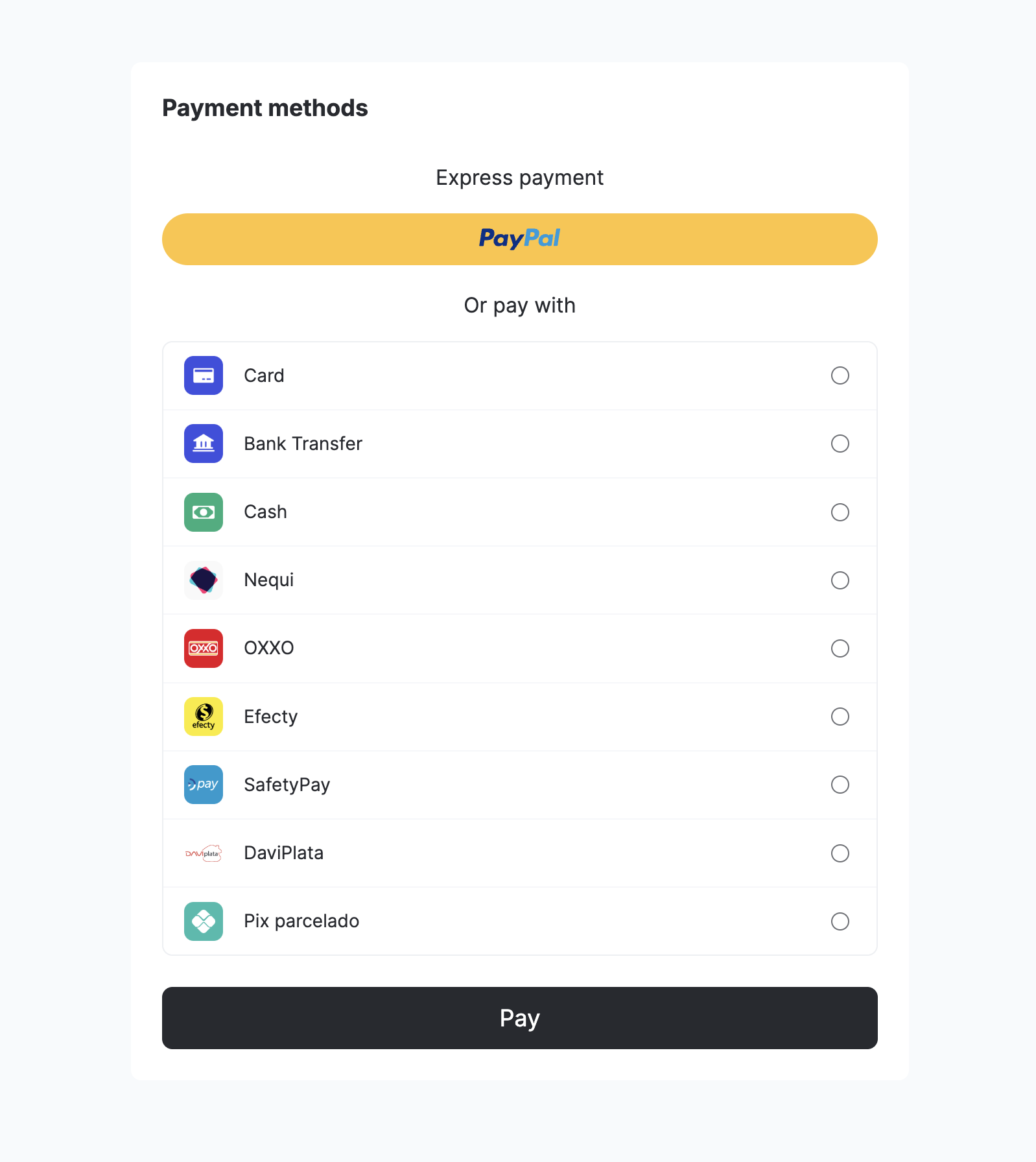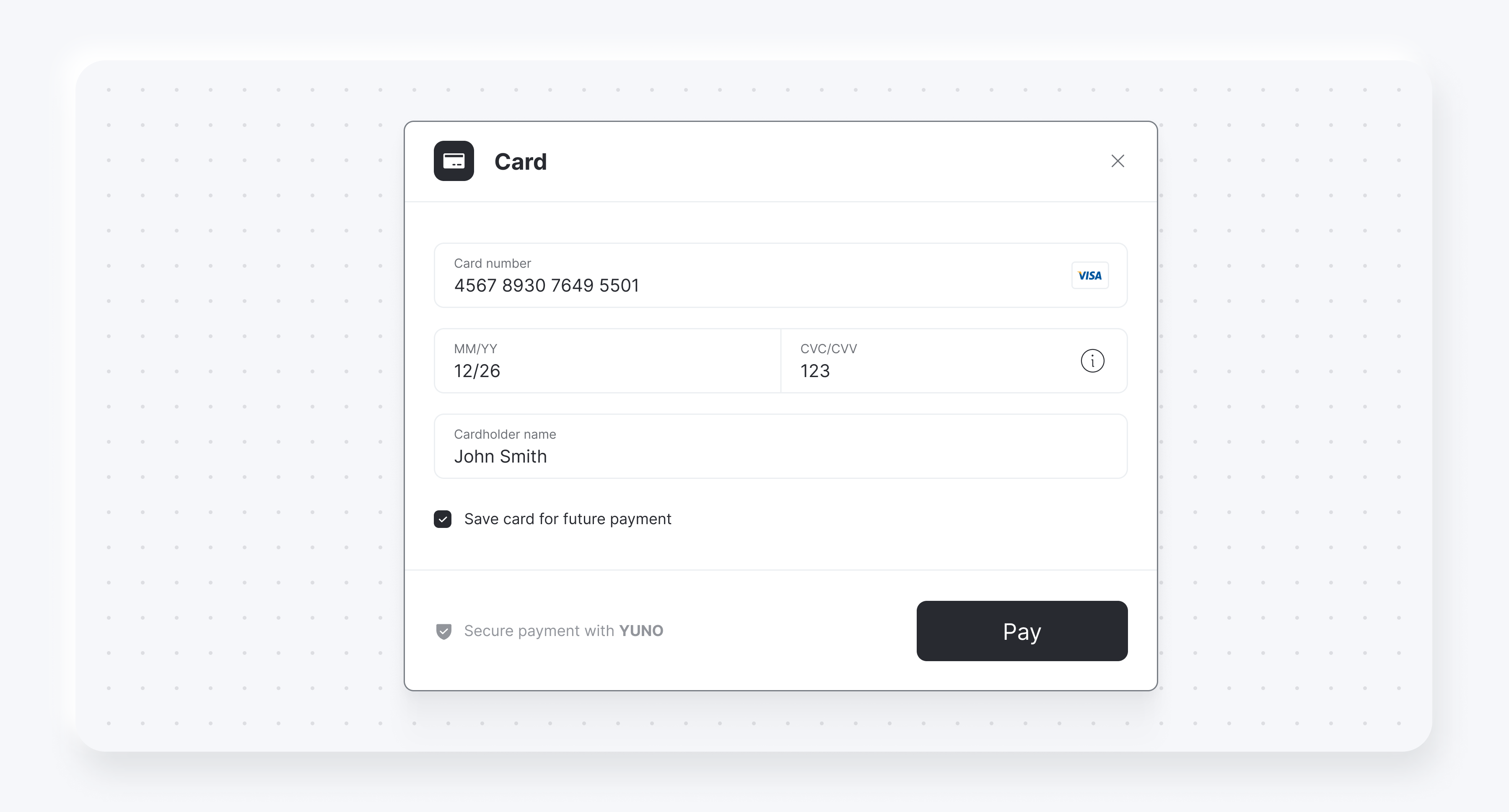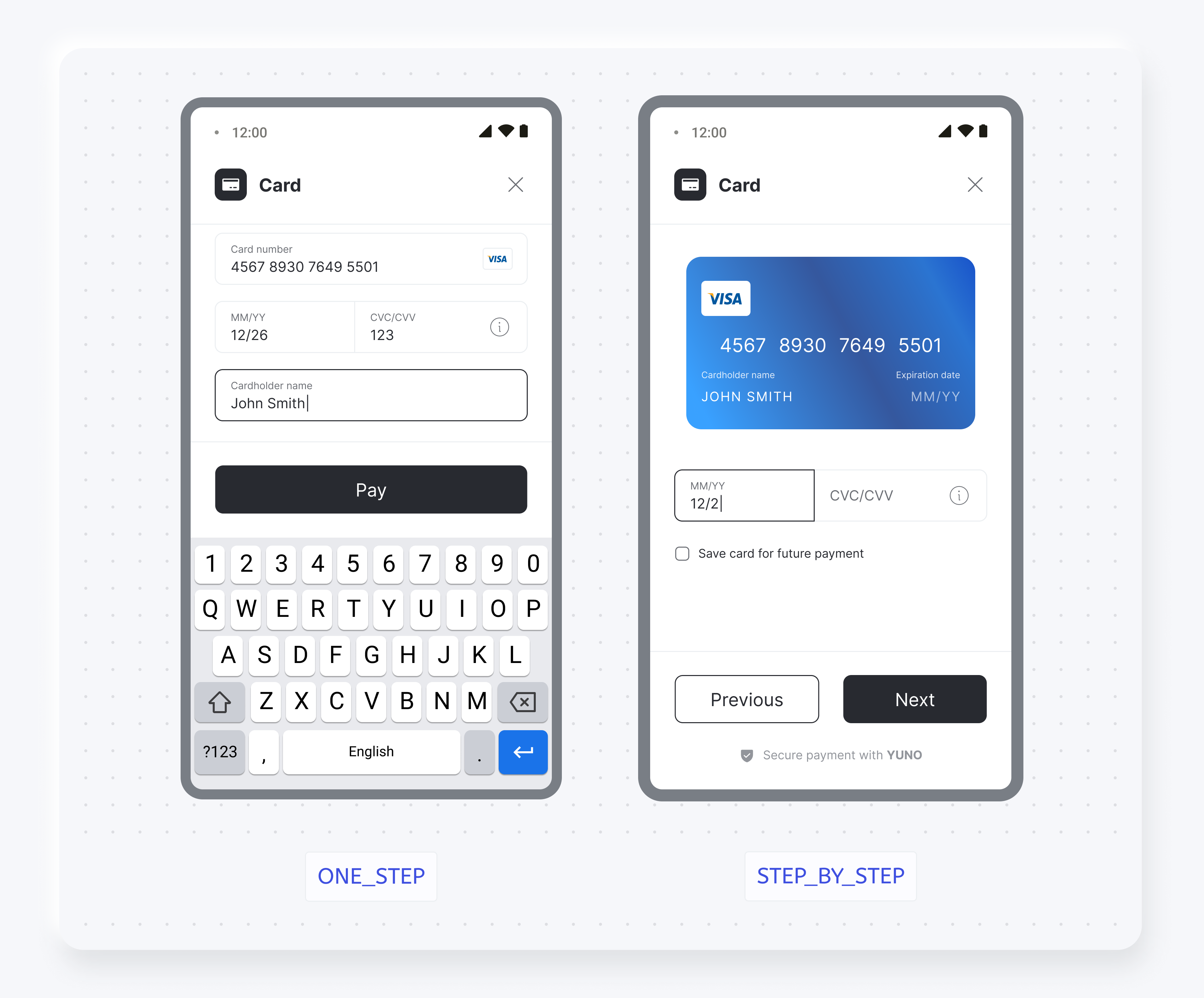Seamless SDK (Payment Android)
This page provides a guide to the Yuno Seamless SDK for Android payments.
Recommended SDKWe recommend using the Android Seamless SDK for a smooth integration experience. This option provides a flexible payment solution with pre-built UI components and customization options.
This SDK is ideal for merchants who:
- Want control over the payment flow while leveraging pre-built UI components
- Need to customize the payment experience while maintaining PCI compliance
- Require a balance between implementation speed and customization
The Seamless SDK includes features like:
- Pre-built payment UI components with customization options
- Multiple payment method support
- Advanced payment status handling
- Comprehensive error management
For merchants requiring complete UI control or more advanced features, consider using our Full SDK instead.

Requirements
Before starting the Yuno Android SDK integration, ensure your project meets the technical requirements. Also, ensure the following prerequisites are in place:
- You must have an active Yuno account.
- You need your Yuno API credentials (
account_id,public-api-key, andprivate-secret-key), which you can obtain from the Developers section of the Yuno dashboard. These credentials are required to authenticate requests to the Yuno API. The API is used to:- Create a
customer, which is required before initiating payments - Create a
checkout_session, which initializes the payment flow - Create the payment associated with the session
- Create a
Verify SDK VersionSee the Release notes or the Yuno Android SDK repository to verify the current SDK version available.
Step 1: Create a customer
Create a customer using the Create customer endpoint before initiating payments. This step is required to:
- Identify the person making the payment
- Enable saved card functionality (if enabled)
- Track payment history
The customer ID returned from this endpoint will be used when creating the checkout_session.
Step 2: Create a checkout session
Create a new checkout_session using the Create checkout session endpoint to initialize the payment flow. Make sure to:
- Include the customer ID obtained from the previous step
- Store the returned
checkout_sessionID for use in Step 6 of the integration
Control auth vs capture by sending
payment_method.detail.card.capturein the checkout session:false= authorize only,true= capture immediately.
Key Parameters
| Parameter | Required | Description |
|---|---|---|
amount | Yes | The primary transaction amount object containing currency (ISO 4217 code) and value (numeric amount in that currency). |
alternative_amount | No | An alternative currency representation of the transaction amount with the same structure as amount (currency and value). Useful for multi-currency scenarios, such as displaying prices to customers in their preferred currency (e.g., USD) while processing the payment in the local currency (e.g., COP). |
Checkout Session UsageThe
checkout_sessionis unique for each payment attempt and cannot be reused.
Step 3: Add SDK to your project
Add the repository source:
maven { url "https://yunopayments.jfrog.io/artifactory/snapshots-libs-release" }Include the following code in the build.gradle file to add the Yuno SDK dependency to the application:
dependencies {
implementation 'com.yuno.payments:android-sdk:{last_version}'
}Step 4: Configure permissions
The Yuno SDK requires network permissions. Ensure the INTERNET permission is included in your AndroidManifest.xml:
<uses-permission android:name="android.permission.INTERNET" />Step 5: Initialize SDK
Retrieve your public API keys from the Yuno dashboard.
If you haven't implemented a custom application, create one. In the onCreate() method of your application class, call the initialize function (Yuno.initialize):
class CustomApplication : Application() {
override fun onCreate() {
super.onCreate()
Yuno.initialize(
this,
PUBLIC_API_KEY,
config = YunoConfig()
)
}
}Use the YunoConfig data class to set additional configurations for the SDK. The following table lists and describes the customization options:
| Option | Description |
|---|---|
| cardFlow | Defines the card form flow. The default option is CardFormType.ONE_STEP. Check the section Render options for more information. |
| saveCardEnabled | Enables the save card checkbox for card flows. Check the Save card section for more information. |
| language | Defines the language to be used in the payment forms. You can set it to one of the available language options:
|
| styles | Enables SDK-wide UI customization. Use it to define global visual styles like font family and button appearance (color, padding, radius, typography) through a YunoStyles object. For more information, check the styles section. |
| cardNumberPlaceholder | This optional field allows you to customize the placeholder text for the card number field. Supports alphanumeric characters, spaces, and UTF-8 characters for localization. If not provided, the SDK uses the default placeholder ("Card number"). This customization does not affect card formatting, masking, BIN logic, or validation. |
| hideCardholderName | This optional field allows you to hide the cardholder name field in the card form. When set to true, the cardholder name field is not rendered. When not specified or set to false, the cardholder name field is displayed (default behavior). Hiding the field does not affect PAN, expiry, CVV collection, BIN logic, or 3DS/provider validations. The merchant is responsible for ensuring cardholder name is provided when required by their payment provider. |
The following code block shows an example of YunoConfig:
data class YunoConfig(
val cardFlow: CardFormType = CardFormType.ONE_STEP,
val saveCardEnabled: Boolean = false,
val language: YunoLanguage? = null,
val styles: YunoStyles? = null,
val cardNumberPlaceholder: String? = null, // Optional: Custom placeholder text for card number field
val hideCardholderName: Boolean? = null // Optional: Set to true to hide cardholder name field
)Step 6: Start checkout
Call the startCheckout method in the onCreate() function of the activity that integrates the SDK to initiate a new payment process with the Seamless SDK:
startCheckout(
checkoutSession: "checkout_session",
country_code: "US",
callbackPaymentState: ((String?) -> Unit)?,
merchantSessionId: String? = null
)| Parameter | Description |
|---|---|
checkoutSession | The checkout_session is related to the payment. |
country_code | Country code where the payment is performed. See Country coverage for a complete list of supported countries and their codes. |
callbackPaymentState | A function that returns the current payment process. Optional if you don't need the result. |
merchantSessionId | Optional identifier for merchant session tracking. Default is null. |
The possible payment states returned by callbackPaymentState are:
const val PAYMENT_STATE_SUCCEEDED = "SUCCEEDED"
const val PAYMENT_STATE_FAIL = "FAIL"
const val PAYMENT_STATE_PROCESSING = "PROCESSING"
const val PAYMENT_STATE_REJECT = "REJECT"
const val PAYMENT_STATE_INTERNAL_ERROR = "INTERNAL_ERROR"
const val PAYMENT_STATE_STATE_CANCELED_BY_USER = "CANCELED"The following table provides additional information about the possible states:
| State | Description | Additional action required |
|---|---|---|
SUCCEEDED | The transaction or payment process was successfully completed without any errors. | No. |
FAIL | The transaction failed due to errors such as data validation issues, server connection failures, or technical/network problems. | Yes. Investigate the cause of failure (validation, network, server) and take corrective measures. |
PROCESSING | The transaction is currently in progress, awaiting approval or verification. | No. |
REJECT | The transaction was rejected due to reasons like insufficient funds or suspected fraudulent activity. | Yes. Inform the user of the rejection, provide the reason if possible, and suggest actions. |
INTERNAL_ERROR | An unexpected internal error occurred within the system handling the payment process. | Yes. Requires technical intervention to review the system, fix internal issues, and retry or inform the user. |
CANCELED | The user voluntarily canceled the transaction or abandoned the payment process. | No. |
Payment status validation
This section explains how the SDK handles payment status when users cancel or leave payment flows, and how the SDK status relates to the backend payment status in these scenarios.
Sync payment methods (Google Pay)
For synchronous payment methods like Google Pay, when a user cancels or closes the wallet UI before a payment service provider (PSP) response is received:
- SDK Status: Returns
CANCELED(CANCELLED_BY_USER) - Backend Payment Status: Remains
PENDINGuntil PSP timeout or merchant cancellation - Important: The SDK will not return
REJECTorPROCESSINGin this scenario
This ensures that the backend payment remains in a pending state and can be properly handled by the merchant's system.
Async payment methods (PIX and QR-based methods)
For asynchronous payment methods like PIX, when a user closes the QR code window (clicks X) before completing the payment:
- SDK Status: Returns
PROCESSING, optionally with a sub-status such asCLOSED_BY_USER - Backend Payment Status: Remains
PENDINGand the QR code remains valid until expiry - Checkout Session Reuse: Re-opening the same checkout session can display the same valid QR code
- No Automatic Cancellation: The PIX payment is not automatically cancelled when the user closes the QR window
This behavior allows users to return to the payment flow and complete the transaction using the same QR code before it expires.
Expired async payments
If a PIX QR code expires naturally:
- Backend Status: Updated to
EXPIRED - SDK Status: SDK callbacks and polling endpoints return
EXPIREDconsistently
This ensures merchants receive accurate status information when a payment method has expired.
Step 7: Get payment one-time token (OTT)
Call the method startPaymentSeamlessLite to start a payment process:
startPaymentSeamlessLite(
paymentSelected: PaymentSelected,
callbackPaymentState: ((String?) -> Unit)?,
showPaymentStatus: Boolean,
)The following table describes the parameters to start the payment:
| Parameter | Description |
|---|---|
paymentSelected | Specifies the payment method, either through a vaulted token or a selected payment type. |
callbackPaymentState | This is an optional parameter. This function handles the state updates. |
showPaymentStatus | This is an optional parameter. When true, displays the SDK's default result screen. |
You will receive the payment status via callbackPaymentState, which will indicate whether the payment was successful or if an issue occurred.
Step 8: Create payment
Call the method startPaymentSeamlessLite with the selected payment method to complete the payment process:
startPaymentSeamlessLite(
paymentSelected: PaymentSelected,
callbackPaymentState: ((String?) -> Unit)?,
showPaymentStatus: Boolean,
)Complementary features
Yuno Android SDK provides additional services and configurations you can use to improve customers' experience. Use the SDK customization to change the SDK appearance to match your brand or to configure the loader.
styles
stylesWith the styles customization option, you can define global visual styles through a YunoStyles object. It lets you apply consistent branding across the SDK by customizing button appearance and typography.
data class YunoStyles(
val buttonStyles: YunoButtonStyles? = null,
val fontFamily: FontFamily? = null
)| Parameter | Description |
|---|---|
buttonStyles | Customizes the primary buttons displayed in the SDK. |
fontFamily | Sets the font family used across all SDK text elements. |
The YunoButtonStyles object lets you define specific settings for button appearance:
data class YunoButtonStyles(
val backgroundColor: Color? = null,
val contentColor: Color? = null,
val cornerRadius: Dp? = null,
val elevation: Dp? = null,
val padding: Dp? = null,
val fontFamily: FontFamily? = null,
val fontSize: TextUnit? = null,
val fontStyle: FontStyle? = null
)Use the YunoConfig data class, described in Step 5, to use the styles customization option.
Loader
The loader functionality is controlled through the keepLoader parameter in the YunoConfig data class, which is documented inline in the SDK configuration section above.
Save card for future payments
You can also display a checkbox to save or enroll cards using cardSaveEnable: true. The following examples show the checkbox for both card form renders:

Render options
You can choose between two card form render options. The following screenshots show the difference between cardFormType ONE_STEP and STEP_BY_STEP:

Demo App AccessIn addition to the code examples provided, you can see the Yuno repository to complete Yuno Android SDKs implementation.
Updated 2 days ago